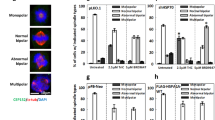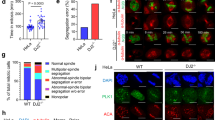Abstract
The Hsp90 inhibitor 17-allylaminogeldanamycin (17-AAG), which is currently in clinical trials, is thought to exert antitumor activity by simultaneously targeting several oncogenic signaling pathways. Here we report a novel mechanism by which 17-AAG inhibits cell proliferation, and we provide the first evidence that HSP90 is required for the assembly of kinetochore protein complexes in humans. 17-AAG caused delocalization of several kinetochore proteins including CENP-I and CENP-H but excluding CENP-B and CENP-C. Consistently, 17-AAG induced a mitotic arrest that depends on the spindle checkpoint and induced misalignment of chromosomes and aneuploidy. We found that HSP90 associates with SGT1 (suppressor of G2 allele of skp1; SUGT1) in human cells and that depletion of SGT1 sensitizes HeLa cells to 17-AAG. Overexpression of SGT1 restored the localization of specific kinetochore proteins and chromosome alignment in cells treated with 17-AAG. Biochemical and genetic results suggest that HSP90, through its interaction with SGT1 (SUGT1), is required for kinetochore assembly. Furthermore, time-course experiments revealed that transient treatment with 17-AAG between late S and G2/M phases causes substantial delocalization of CENP-H and CENP-I, a finding that strongly suggests that HSP90 participates in kinetochore assembly in a cell cycle-dependent manner.
This is a preview of subscription content, access via your institution
Access options
Subscribe to this journal
Receive 50 print issues and online access
$259.00 per year
only $5.18 per issue
Buy this article
- Purchase on Springer Link
- Instant access to full article PDF
Prices may be subject to local taxes which are calculated during checkout






Similar content being viewed by others
References
Andreassen PR, Skoufias DA, Margolis RL . (2004). Methods Mol Biol 281: 213–225.
Arlander SJ, Eapen AK, Vroman BT, McDonald RJ, Toft DO, Karnitz LM . (2003). J Biol Chem 278: 52572–52577.
Bansal PK, Abdulle R, Kitagawa K . (2004). Mol Cell Biol 24: 8069–8079.
Basso AD, Solit DB, Munster PN, Rosen N . (2002). Oncogene 21: 1159–1166.
Beliakoff J, Whitesell L . (2004). Anticancer Drugs 15: 651–662.
Biggins S, Walczak CE . (2003). Curr Biol 13: R449–R460.
Blasco MA, Lee HW, Hande MP, Samper E, Lansdorp PM, DePinho RA et al. (1997). Cell 91: 25–34.
Carvalho A, Carmena M, Sambade C, Earnshaw WC, Wheatley SP . (2003). J Cell Sci 116: 2987–2998.
Connelly C, Hieter P . (1996). Cell 86: 275–285.
de Carcer G . (2004). Cancer Res 64: 5106–5112.
DeLuca JG, Dong Y, Hergert P, Strauss J, Hickey JM, Salmon ED et al. (2005). Mol Biol Cell 16: 519–531.
Doheny KF, Sorger PK, Hyman AA, Tugendreich S, Spencer F, Hieter P . (1993). Cell 73: 761–774.
Drouin R, Lemieux N, Richer CL . (1988). Cytobios 56: 107–125.
Elbashir SM, Harborth J, Lendeckel W, Yalcin A, Weber K, Tuschl T . (2001). Nature 411: 494–498.
Fortugno P, Beltrami E, Plescia J, Fontana J, Pradhan D, Marchisio PC et al. (2003). Proc Natl Acad Sci USA 100: 13791–13796.
Fukagawa T, Mikami Y, Nishihashi A, Regnier V, Haraguchi T, Hiraoka Y et al. (2001). EMBO J 20: 4603–4617.
Goetz MP, Toft D, Reid J, Ames M, Stensgard B, Safgren S et al. (2005). J Clin Oncol 23: 1078–1087.
Goetz MP, Toft DO, Ames MM, Erlichman C . (2003). Ann Oncol 14: 1169–1176.
Goh PY, Kilmartin JV . (1993). J Cell Biol 121: 503–512.
Grenert JP, Johnson BD, Toft DO . (1999). J Biol Chem 274: 17525–17533.
Hostein I, Robertson D, DiStefano F, Workman P, Clarke PA . (2001). Cancer Res 61: 4003–4009.
Jiang W, Lechner J, Carbon J . (1993). J Cell Biol 121: 513–519.
Kaplan KB, Hyman AA, Sorger PK . (1997). Cell 91: 491–500.
Kelland LR, Sharp SY, Rogers PM, Myers TG, Workman P . (1999). J Natl Cancer Inst 91: 1940–1949.
Kitagawa K, Abdulle R . (2002). Biotechniques 33: 288, 290, 292 passim.
Kitagawa K, Hieter P . (2001). Nat Rev Mol Cell Biol 2: 678–687.
Kitagawa K, Skowyra D, Elledge SJ, Harper JW, Hieter P . (1999). Mol Cell 4: 21–33.
Kranc KR, Bamforth SD, Braganca J, Norbury C, van Lohuizen M, Bhattacharya S . (2003). Mol Cell Biol 23: 7658–7666.
Lamb JR, Tugendreich S, Hieter P . (1995). Trends Biochem Sci 20: 257–259.
Lechner J, Carbon J . (1991). Cell 64: 717–725.
Lechner J . (1994). EMBO J 13: 5203–5211.
Lens SM, Wolthuis RM, Klompmaker R, Kauw J, Agami R, Brummelkamp T et al. (2003). EMBO J 22: 2934–2947.
Lingelbach LB, Kaplan KB . (2004). Mol Cell Biol 24: 8938–8950.
Martin-Lluesma S, Stucke VM, Nigg EA . (2002). Science 297: 2267–2270.
Masumoto H, Masukata H, Muro Y, Nozaki N, Okazaki T . (1989). J Cell Biol 109: 1963–1973.
McEwen BF, Chan GK, Zubrowski B, Savoian MS, Sauer MT, Yen TJ . (2001). Mol Biol Cell 12: 2776–2789.
McEwen BF, Heagle AB, Cassels GO, Buttle KF, Rieder CL . (1997). J Cell Biol 137: 1567–1580.
Meraldi P, Sorger PK . (2005). EMBO J 24: 1621–1633.
Munster PN, Srethapakdi M, Moasser MM, Rosen N . (2001). Cancer Res 61: 2945–2952.
Neckers L, Ivy SP . (2003). Curr Opin Oncol 15: 419–424.
Neckers L . (2002). Clin Cancer Res 8: 962–966.
Nimmanapalli R, O’Bryan E, Bhalla K . (2001). Cancer Res 61: 1799–1804.
Obermann WM, Sondermann H, Russo AA, Pavletich NP, Hartl FU . (1998). J Cell Biol 143: 901–910.
Panaretou B, Prodromou C, Roe SM, O’Brien R, Ladbury JE, Piper PW et al. (1998). EMBO J 17: 4829–4836.
Panaretou B, Siligardi G, Meyer P, Maloney A, Sullivan JK, Singh S et al. (2002). Mol Cell 10: 1307–1318.
Piper PW, Panaretou B, Millson SH, Trumana A, Mollapour M, Pearl LH et al. (2003). Gene 302: 165–170.
Prodromou C, Roe SM, O’Brien R, Ladbury JE, Piper PW, Pearl LH . (1997). Cell 90: 65–75.
Reilly PT, Wysocka J, Herr W . (2002). Mol Cell Biol 22: 6767–6778.
Solit DB, Zheng FF, Drobnjak M, Munster PN, Higgins B, Verbel D et al. (2002). Clin Cancer Res 8: 986–993.
Srethapakdi M, Liu F, Tavorath R, Rosen N . (2000). Cancer Res 60: 3940–3946.
Stebbins CE, Russo AA, Schneider C, Rosen N, Hartl FU, Pavletich NP . (1997). Cell 89: 239–250.
Steensgaard P, Garre M, Muradore I, Transidico P, Nigg EA, Kitagawa K et al. (2004). EMBO Rep 5: 626–631.
Stemmann O, Lechner J . (1996). EMBO J 15: 3611–3620.
Stemmann O, Neidig A, Kocher T, Wilm M, Lechner J . (2002). Proc Natl Acad Sci USA 99: 8585–8590.
Strunnikov AV, Kingsbury J, Koshland D . (1995). J Cell Biol 128: 749–760.
Tatsumi Y, Ohta S, Kimura H, Tsurimoto T, Obuse C . (2003). J Biol Chem 278: 41528–41534.
Taylor SS, Hussein D, Wang Y, Elderkin S, Morrow CJ . (2001). J Cell Sci 114: 4385–4395.
Ten Hagen KG, Gilbert DM, Willard HF, Cohen SN . (1990). Mol Cell Biol 10: 6348–6355.
Tugendreich S, Tomkiel J, Earnshaw W, Hieter P . (1995). Cell 81: 261–268.
Workman P . (2003). Curr Cancer Drug Targets 3: 297–300.
Yang Z, Guo J, Chen Q, Ding C, Du J, Zhu X . (2005). Mol Cell Biol 25: 4062–4074.
Yoda K, Nakamura T, Masumoto H, Suzuki N, Kitagawa K, Nakano M et al. (1996). Mol Cell Biol 16: 5169–5177.
Acknowledgements
We thank TJ Yen, J Partridge, V Measday, P Bansal, and R Kitagawa for their helpful comments; J Lahti, S Moshiach, G Murti, L Mann, M Sugimoto, K Tago, R Kitagawa, and J Easton for stimulating conversation and advice; A-M Hamilton-Easton and R Ashmun for FACS analysis; E Law for technical assistance; A Mishra, V Pagala, K Kodali, and C Slaughter for mass spectrometry; EA Nigg, J Lahti, DC Altieri, TJ Yen, WC Earnshaw, WR Brinkley, SS Taylor, and K Sullivan for their generous gifts of reagents; and AJ McArthur and JR Davies for editing this manuscript.This work was supported by the Cancer Center Support Grant CA21765 from the National Cancer Institute, by National Institutes of Health grant GM68418, and by the American Lebanese Syrian Associated Charities (ALSAC). BFM is supported by National Institutes of Health Grant GM066270 and National Science Foundation Grant MCB0110821.
Author information
Authors and Affiliations
Corresponding author
Additional information
Supplementary Information accompanies the paper on Oncogene website (http://www.nature.com/onc).
Rights and permissions
About this article
Cite this article
Niikura, Y., Ohta, S., Vandenbeldt, K. et al. 17-AAG, an Hsp90 inhibitor, causes kinetochore defects: a novel mechanism by which 17-AAG inhibits cell proliferation. Oncogene 25, 4133–4146 (2006). https://doi.org/10.1038/sj.onc.1209461
Received:
Revised:
Accepted:
Published:
Issue Date:
DOI: https://doi.org/10.1038/sj.onc.1209461



